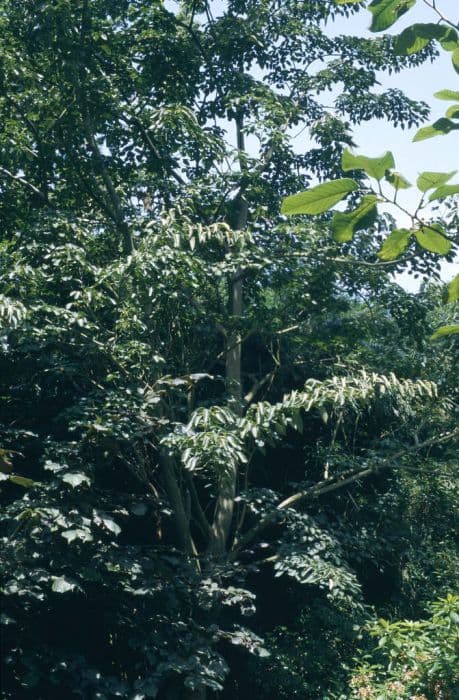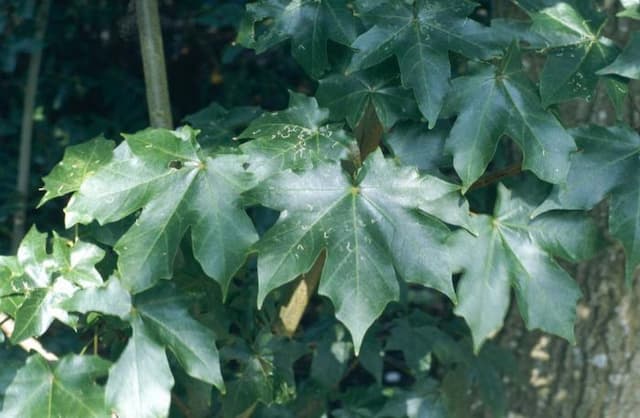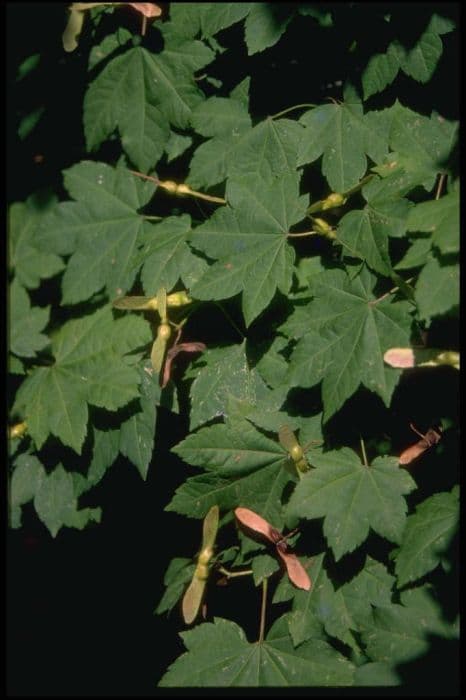Japanese Maple Acer palmatum 'Shin-deshojo' (P)

ABOUT
The Japanese maple known as 'Shin-deshojo' is renowned for its stunning foliage which showcases a variety of vibrant colors throughout the growing seasons. In spring, the leaves emerge with a fiery red hue, creating a striking and vivid display that captures the eye. The red color is especially bright and clear, making it a standout specimen in any garden or landscape. As the season progresses into summer, these leaves may transition to include shades of green while maintaining hints of that initial red, giving the foliage a two-toned effect of greenish-red to deep burgundy depending on the light exposure and maturity of the leaf. The intricate leaves themselves have a classic shape that is deeply lobed and finely textured, providing a delicate look that contrasts nicely against the more bold coloration. In the fall, the Japanese maple 'Shin-deshojo' transforms once again, as the leaves take on a variety of tones including fiery reds, bright oranges, and sometimes a captivating purple. This bouquet of autumn color offers a final, spectacular display before the leaves drop for winter. The bark of the 'Shin-deshojo' Japanese maple is typically a smooth gray, offering a calming backdrop against which the colors of the leaves can truly pop. The structure of the tree is elegant with a branching pattern that spreads outwards and creates a graceful, rounded shape that adds to its ornamental value. The overall appearance of this Japanese maple is one of both vibrancy and elegance, making it a favorite for those looking to add a splash of color and delicate texture to their garden without concern for its size.
About this plant
 Names
NamesFamily
Sapindaceae
Synonyms
Japanese Maple, Red Japanese Maple, Shin-deshojo Japanese Maple
Common names
Acer palmatum 'Shin-deshojo'
 Toxicity
ToxicityTo humans
Japanese maple is generally not considered toxic to humans. There are no significant reports of poisoning or toxic reactions from ingestion of this plant. As with any plant material, individual sensitivities can vary, and ingestion may cause gastrointestinal discomfort in some people.
To pets
Japanese maple is not known to be toxic to cats and dogs. It is not listed on common toxic plant databases for pets, and there are no widespread reports of pets being poisoned by eating parts of this plant. However, ingestion of plant material may potentially cause mild stomach upset in some pets.
 Characteristics
CharacteristicsLife cycle
Perennials
Foliage type
Deciduous
Color of leaves
Red
Height
5 feet [1.5 meters]
Spread
5 feet [1.5 meters]
Plant type
Tree
Hardiness zones
5
Native area
Japan
Benefits
 General Benefits
General Benefits- Ornamental Value: Japanese Maple 'Shin-deshojo' is highly prized for its aesthetic appeal due to its vibrant crimson-red leaves in the spring that gradually transition to green and then to a magnificent red in fall.
- Compact Size: It's a small-sized tree suitable for gardens with limited space or can be grown in containers, making it versatile for various landscaping needs.
- Shade Provider: Its canopy can create a cool, shaded area in the garden, making it a good choice for seating areas or patios.
- Wildlife Attraction: Provides habitat and food for birds and other wildlife, enhancing biodiversity in the garden.
- Seasonal Interest: Offers year-round interest with changing leaf colors, delicate flowers in spring, and interesting bark texture in the winter.
- Cultural Symbolism: In Japan, the Maple (Acer) is a symbol of elegance and tranquility, and it can bring these aspects into a garden design.
- Low Maintenance: Requires minimal pruning and is relatively low maintenance compared to other ornamental trees.
 Medical Properties
Medical PropertiesThis plant is not used for medical purposes.
 Air-purifying Qualities
Air-purifying QualitiesThis plant is not specifically known for air purifying qualities.
 Other Uses
Other Uses- Acer palmatum 'Shin-deshojo', commonly known as Japanese maple, can be used in bonsai cultivation due to its attractive foliage and adaptability to pruning and shaping.
- The wood of Japanese maple is sometimes used in the creation of small woodworks or decorative objects, as it can have a pleasing grain and color.
- The fallen leaves of Japanese maple can be collected and used as a natural mulch in gardens, providing nutrients to the soil as they decompose.
- Japanese maples can be used in art classes or nature studies for leaf rubbings, allowing students to explore the vein patterns and shape of the leaves.
- The tree can serve as a natural sunshade in gardens, especially when strategically planted to protect understory plants from excessive sunlight.
- Dried leaves of the Japanese maple can be incorporated into craft projects, such as handmade paper, for texture and visual interest.
- In photography, the vibrant red leaves of the 'Shin-deshojo' variety of Japanese maple can serve as a stunning backdrop or focal point for outdoor portraits.
- Japanese maples can be used in landscape design not only for aesthetic purposes but also to create natural windbreaks in residential gardens.
- The thin, delicate branches of young Japanese maple trees can be used in floral arrangements or wreaths for a touch of natural elegance.
- During the autumn season, the colorful foliage of the Japanese maple provides a scenic attraction for nature walks, local parks, or outdoor educational tours.
Interesting Facts
 Feng Shui
Feng ShuiThe Japanese Maple is not used in Feng Shui practice.
 Zodiac Sign Compitability
Zodiac Sign CompitabilityThe Japanese Maple is not used in astrology practice.
 Plant Symbolism
Plant Symbolism- Beauty: The Shin-deshojo Maple, known for its beautiful crimson-red leaves, is often associated with aesthetic beauty and the visual pleasures of nature.
- Change and Transformation: As a deciduous tree that undergoes color change with the seasons, Shin-deshojo Maples symbolize change and the ability to adapt and transform over time.
- Peace and Serenity: Like many maples, the calm and poised appearance of the Shin-deshojo Maple represents peace and serenity, making it a common choice for zen gardens.
- Endurance and Strength: Maples, in general, are hardy trees that can withstand various conditions. The Shin-deshojo Maple’s resilience through seasonal changes symbolizes endurance and inner strength.
- Balance: Shin-deshojo Maples are often used in Japanese gardens where they play a role in creating visual harmony and balance, symbolizing the ideal of living a balanced life.
 Water
WaterThe Japanese Maple, specifically the 'Shin-deshojo' variety, needs regular watering to keep the soil consistently moist but not soggy. During the growing season, it may require water once or twice a week, depending on weather conditions. Each watering session should provide enough water to soak the root zone; this typically means using around 1-2 gallons per week for a young tree, but mature trees might need more. The exact amount can vary based on soil type and temperature. During the winter months, reduce watering as the tree goes dormant and its water requirements decrease.
 Light
LightJapanese Maples, including the 'Shin-deshojo', thrive best in a spot with dappled or partial shade. Direct sunlight can be tolerated especially when the tree is well-watered, but to protect the vibrant red leaves of the 'Shin-deshojo' from scorching, it is advised to provide afternoon shade. An eastern exposure, receiving morning sun and afternoon shade, is often ideal for optimal leaf coloration and health.
 Temperature
TemperatureThe Japanese Maple 'Shin-deshojo' is hardy to colder temperatures and can survive minimum winter temperatures down to -10 to -20 degrees Fahrenheit, but it prefers a temperate climate. The ideal temperature range for robust growth and health lies between 60 and 80 degrees Fahrenheit. Protection from extreme cold and harsh winds is beneficial to prevent damage to this ornamental tree.
 Pruning
PruningPruning Japanese Maple 'Shin-deshojo' is essential for maintaining its shape, health, and to encourage more vibrant foliage. Prune in late winter or early spring before new growth begins, removing any dead, damaged, or crossing branches. Thin out the canopy to allow light into the center of the tree, but prune sparingly as excessive cutting can lead to a weak structure. The best time to shape the tree for aesthetic purposes is during this dormant period.
 Cleaning
CleaningAs needed
 Soil
SoilJapanese Maple thrives in well-draining, acidic to neutral soil (pH 5.5-7.0). A mix of loamy soil, peat moss, and perlite or well-rotted pine bark promotes healthy growth.
 Repotting
RepottingJapanese Maple should be repotted every 2-3 years in early spring, before the growing season starts, to prevent root constriction and ensure continued health.
 Humidity & Misting
Humidity & MistingJapanese Maple prefers moderate humidity levels but is adaptable to the ambient humidity found in most garden environments without needing special care.
 Suitable locations
Suitable locationsIndoor
Bright, indirect light with cool temperatures suits indoor Japanese Maple.
Outdoor
Provide dappled shade, shelter from strong winds, and regular watering.
Hardiness zone
5-9 USDA
 Life cycle
Life cycleAcer palmatum 'Shin-deshojo', commonly known as Japanese Maple, begins its life cycle as a seed, which germinates in favorable conditions of moisture and temperature, usually in spring. After germination, the seedling emerges, establishing itself with a root system and a shoot that will develop into a trunk and branches. In its juvenile phase, the tree spends several years developing a robust root system, sturdy trunk, and branching structure, growing more each year with the proper balance of sunlight, water, and nutrients. The tree reaches maturity in several more years, capable of flowering and producing its own seeds; the deeply lobed leaves are initially bright red in spring, transitioning to green in summer, then to fiery colors in the fall before leaf drop. Throughout its life, the Japanese Maple will undergo seasonal changes, with growth in the spring and summer and a period of dormancy in the winter when it conserves energy. The life span of this tree can be many decades, even over a century in optimal conditions, during which time it may face various environmental stresses from pests, diseases, and weather but with proper care can continue to thrive and reproduce.
 Propogation
PropogationPropogation time
Early spring
The Japanese maple 'Shin-deshojo' is commonly propagated through grafting, which is a popular method owing to its ability to ensure the offspring retain the same characteristics as the parent plant. Grafting is typically performed during the dormant season in late winter to early spring. In this process, a stem from the 'Shin-deshojo' with at least one bud is joined to a rootstock of another maple that has been grown specifically for this purpose. The union between the scion (the 'Shin-deshojo' stem) and the rootstock is carefully wrapped and sealed to prevent drying out and to foster the tissues of the two parts to grow together. It is essential to maintain proper temperature and humidity levels to ensure the graft takes successfully. After some weeks, when the graft has taken and is growing well, it can then be planted out or potted on to grow to a saleable size.





![Freeman maple [Autumn Blaze]](/_next/image?url=https%3A%2F%2Fplants-admin.emdemapps.com%2Fimages%2Fplants%2F%2Fimages%2F604b575b84d87.png&w=640&q=75)



